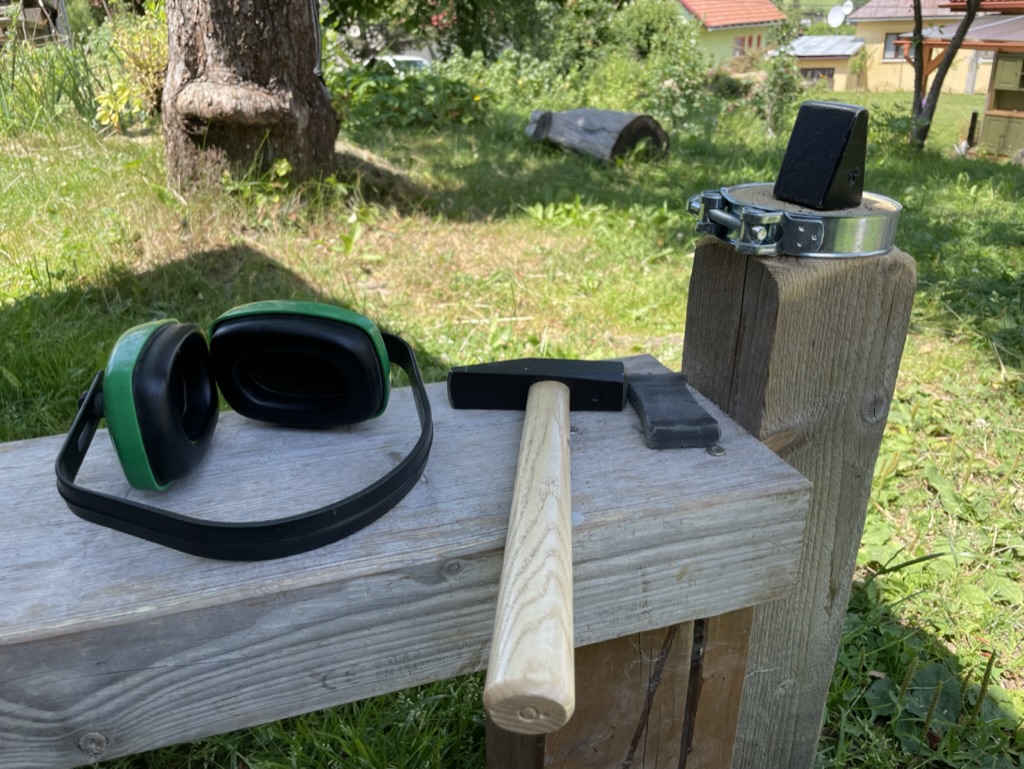Peening (hammering) of scythe
Peening, hammering, tapping, or sharpening a scythe – depending on the region, you may encounter different names for the same technique. Basically, it involves shaping the blade of a scythe with a hammer to make it thinner and more pointed.
It is an essential technique for achieving maximum sharpness of the scythe, which then allows you to mow grass with ease and minimal effort.
There are several techniques for peening, but our experience has shown that in terms of effort/result, peening the scythe on a narrow anvil (nákove) with the flat side of the hammer is the best method. Unlike peening a scythe on a flat anvil with the sharp side of the hammer, this method does not require 100% accuracy of the blows, and if you strike next to the target, there is no risk of the scythe losing its tension, warping, and becoming unusable. The seemingly simple peening of the scythe on a peening jig is difficult to match in terms of the final quality of the peening compared to the methods described above.

Peening a scythe on a narrow anvil step by step:
THE BASIC IS TO HIT THE TARGET. Before you start working, test the accuracy of your strikes by hammering small-headed nails into wood. Pay attention not only to the accuracy of your strikes, but also to their strength, which should be approximately the same. If you have hammered 20-30 nails in a row without bending or missing any, you are ready. Do not use a peening hammer for this training; keep it reserved for this purpose only.
CLEAN THE SCYTHE THOROUGHLY of all grass or soil residues. Use sandpaper or a sponge to remove any rust. If the scythe is new, remove the protective lacquer from the blade. A clean scythe allows for smooth movement across the grass, which makes work much easier.
DULL THE BLADE WITH A GRINDING BLOCK. On dull metal, you will see shiny marks from the hammer, which form a continuous line as you gradually move across the blade. This "trick" is especially appreciated by beginners. We have found the Schleiffix grinding block to be the most effective for dulling the blade.

With each stroke of the hammer, the scythe blade stretches a little, becoming thinner and sharper.
LAY THE SCYTHE ON THE PEENING ANVIL so that the cutting edge is positioned just behind the top of the anvil, facing you. Hold it firmly from above and rest the tips of your fingers on the bottom of the anvil. Your fingers will serve as a stop to keep the blade in the correct position on the anvil. Depending on the current position of the scythe on the anvil, support the scythe with one knee or the other.
STRIKE WITH THE HAMMER only where the blade of the scythe is level with the surface of the anvil.
PULL OUT THE BLADE with a pulling stroke. Hold your hand so that your upper arm and forearm are at an angle of approximately 80-90° and isolate the movement to the shoulder joint. With a pulling hammer blow towards you, gradually pull out the material of the scythe. Gradually move millimeter by millimeter along the entire length of the blade, so that the shiny marks left by the blows form a continuous line. If necessary, repeat 2-3 times.
DIRECT HIT WITH A HAMMER - isolate the movement to the elbow joint, with the hammer hitting the scythe directly downwards. This blow is used for final thinning of the blade, further thinning the cutting edge, while at the same time hardening the steel and making it more resistant. Gradually work your way along the entire length of the blade, millimeter by millimeter, so that the shiny marks left by the blows form a continuous line. Repeat twice if necessary.
SHARPEN THE SCYTHE WITH A Whetstone If you are a beginner, first use a whetstone with a coarser grain and then remove the burr with a finer whetstone. Experienced users can sharpen the scythe directly with a fine whetstone, e.g. Rozsutec.
